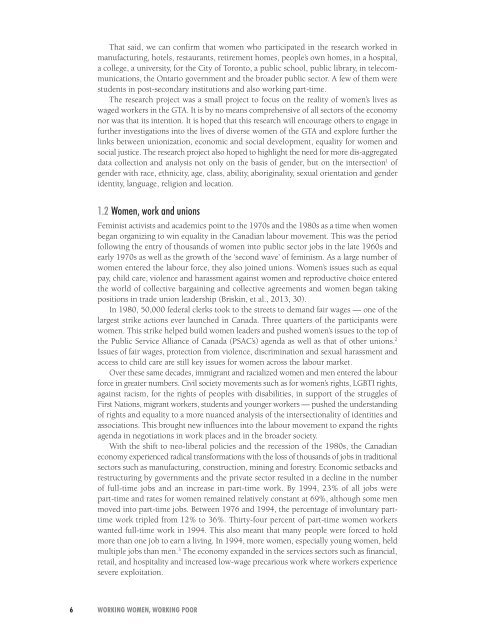workingwomenworkingpoor_letter_web
workingwomenworkingpoor_letter_web
workingwomenworkingpoor_letter_web
You also want an ePaper? Increase the reach of your titles
YUMPU automatically turns print PDFs into web optimized ePapers that Google loves.
That said, we can confirm that women who participated in the research worked inmanufacturing, hotels, restaurants, retirement homes, people’s own homes, in a hospital,a college, a university, for the City of Toronto, a public school, public library, in telecommunications,the Ontario government and the broader public sector. A few of them werestudents in post-secondary institutions and also working part-time.The research project was a small project to focus on the reality of women’s lives aswaged workers in the GTA. It is by no means comprehensive of all sectors of the economynor was that its intention. It is hoped that this research will encourage others to engage infurther investigations into the lives of diverse women of the GTA and explore further thelinks between unionization, economic and social development, equality for women andsocial justice. The research project also hoped to highlight the need for more dis-aggregateddata collection and analysis not only on the basis of gender, but on the intersection 1 ofgender with race, ethnicity, age, class, ability, aboriginality, sexual orientation and genderidentity, language, religion and location.1.2 Women, work and unionsFeminist activists and academics point to the 1970s and the 1980s as a time when womenbegan organizing to win equality in the Canadian labour movement. This was the periodfollowing the entry of thousands of women into public sector jobs in the late 1960s andearly 1970s as well as the growth of the ‘second wave’ of feminism. As a large number ofwomen entered the labour force, they also joined unions. Women’s issues such as equalpay, child care, violence and harassment against women and reproductive choice enteredthe world of collective bargaining and collective agreements and women began takingpositions in trade union leadership (Briskin, et al., 2013, 30).In 1980, 50,000 federal clerks took to the streets to demand fair wages — one of thelargest strike actions ever launched in Canada. Three quarters of the participants werewomen. This strike helped build women leaders and pushed women’s issues to the top ofthe Public Service Alliance of Canada (PSAC’s) agenda as well as that of other unions. 2Issues of fair wages, protection from violence, discrimination and sexual harassment andaccess to child care are still key issues for women across the labour market.Over these same decades, immigrant and racialized women and men entered the labourforce in greater numbers. Civil society movements such as for women’s rights, LGBTI rights,against racism, for the rights of peoples with disabilities, in support of the struggles ofFirst Nations, migrant workers, students and younger workers — pushed the understandingof rights and equality to a more nuanced analysis of the intersectionality of identities andassociations. This brought new influences into the labour movement to expand the rightsagenda in negotiations in work places and in the broader society.With the shift to neo-liberal policies and the recession of the 1980s, the Canadianeconomy experienced radical transformations with the loss of thousands of jobs in traditionalsectors such as manufacturing, construction, mining and forestry. Economic setbacks andrestructuring by governments and the private sector resulted in a decline in the numberof full-time jobs and an increase in part-time work. By 1994, 23% of all jobs werepart-time and rates for women remained relatively constant at 69%, although some menmoved into part-time jobs. Between 1976 and 1994, the percentage of involuntary parttimework tripled from 12% to 36%. Thirty-four percent of part-time women workerswanted full-time work in 1994. This also meant that many people were forced to holdmore than one job to earn a living. In 1994, more women, especially young women, heldmultiple jobs than men. 3 The economy expanded in the services sectors such as financial,retail, and hospitality and increased low-wage precarious work where workers experiencesevere exploitation.6 WORKING WOMEN, WORKING POOR


